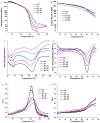Synthesis and evaluation of novel dental monomer with branched carboxyl acid group
- PMID: 24596134
- PMCID: PMC4156564
- DOI: 10.1002/jbm.b.33126
Synthesis and evaluation of novel dental monomer with branched carboxyl acid group
Abstract
To enhance the water miscibility and increase the mechanical properties of dentin adhesives, a new glycerol-based monomer with vinyl and carboxylic acid, 4-((1,3-bis(methacryloyloxy)propan-2-yl)oxy)-2-methylene-4-oxobutanoic acid (BMPMOB), was synthesized and characterized. Dentin adhesive formulations containing 2-hydroxyethyl methacrylate (HEMA), 2,2-bis[4-(2-hydroxy-3-methacryloxypropoxy) phenyl]propane (BisGMA), and BMPMOB were characterized with regard to real-time photopolymerization behavior, water sorption, dynamic mechanical analysis, and microscale three-dimensional internal morphologies and compared with HEMA/BisGMA controls. The experimental adhesive copolymers showed higher glass transition temperature and rubbery moduli, as well as improved water miscibility compared to the controls. The enhanced properties of the adhesive copolymers indicated that BMPMOB is a promising comonomer for dental restorative materials.
Keywords: crosslink polymer; dentin adhesive; dynamical mechanical property; photopolymerization; water miscibility.
© 2014 Wiley Periodicals, Inc.
Figures







Similar articles
-
Probing the dual function of a novel tertiary amine compound in dentin adhesive formulations.Dent Mater. 2016 Apr;32(4):519-28. doi: 10.1016/j.dental.2015.12.003. Epub 2016 Jan 5. Dent Mater. 2016. PMID: 26764171 Free PMC article.
-
Synthesis and evaluation of novel dental monomer with branched aromatic carboxylic acid group.J Biomed Mater Res B Appl Biomater. 2012 Feb;100(2):569-76. doi: 10.1002/jbm.b.31987. Epub 2011 Nov 24. J Biomed Mater Res B Appl Biomater. 2012. PMID: 22114017 Free PMC article.
-
The influence of chemical structure on the properties in methacrylate-based dentin adhesives.Dent Mater. 2011 Nov;27(11):1086-93. doi: 10.1016/j.dental.2011.07.011. Epub 2011 Aug 3. Dent Mater. 2011. PMID: 21816460 Free PMC article.
-
New silyl-functionalized BisGMA provides autonomous strengthening without leaching for dental adhesives.Acta Biomater. 2019 Jan 1;83:130-139. doi: 10.1016/j.actbio.2018.10.033. Epub 2018 Oct 24. Acta Biomater. 2019. PMID: 30366133 Free PMC article.
-
A review of our development of dental adhesives--effects of radical polymerization initiators and adhesive monomers on adhesion.Dent Mater J. 2010 Mar;29(2):109-21. doi: 10.4012/dmj.2009-057. Dent Mater J. 2010. PMID: 20379020 Review.
Cited by
-
Engineering Interfacial Integrity with Hydrolytic-Resistant, Self-Reinforcing Dentin Adhesive.Int J Mol Sci. 2024 Jun 27;25(13):7061. doi: 10.3390/ijms25137061. Int J Mol Sci. 2024. PMID: 39000170 Free PMC article.
-
Degradation of poly(β-amino ester) gels in alcohols through transesterification: A method to conjugate drugs to polymer matrices.J Polym Sci A Polym Chem. 2017 Jun 15;55(12):2019-2026. doi: 10.1002/pola.28579. Epub 2017 Mar 25. J Polym Sci A Polym Chem. 2017. PMID: 29398778 Free PMC article.
-
Sorption, solubility and cytotoxicity of novel antibacterial nanofilled dental adhesive resins.Sci Rep. 2020 Aug 11;10(1):13503. doi: 10.1038/s41598-020-70487-z. Sci Rep. 2020. PMID: 32782299 Free PMC article.
-
Probing the dual function of a novel tertiary amine compound in dentin adhesive formulations.Dent Mater. 2016 Apr;32(4):519-28. doi: 10.1016/j.dental.2015.12.003. Epub 2016 Jan 5. Dent Mater. 2016. PMID: 26764171 Free PMC article.
-
Tris(trimethylsilyl)silane as a co-initiator for dental adhesive: Photo-polymerization kinetics and dynamic mechanical property.Dent Mater. 2016 Jan;32(1):102-13. doi: 10.1016/j.dental.2015.10.013. Epub 2015 Nov 27. Dent Mater. 2016. PMID: 26616688 Free PMC article.
References
-
- Burrow MF, Satoh M, Tagami J. Dentin bond durability after three years using a dentin bonding agent with and without priming. Dent Mater. 1996;12(5–6):302–307. - PubMed
-
- Hashimoto M, Ohno H, Kaga M, Endo K, Sano H, Oguchi H. In vivo degradation of resin-dentin bonds in humans over 1 to 3 years. J Dent Res. 2000;79(6):1385–1391. - PubMed
-
- Hashimoto M, Ohno H, Sano H, Tay FR, Kaga M, Kudou Y, Oguchi H, Araki Y, Kubota M. Micromorphological changes in resin–dentin bonds after 1 year of water storage. J Biomed Mater Res. 2002;63(3):306–311. - PubMed
-
- Sano H, Yoshikawa T, Pereira PNR, Kanemura N, Morigami M, Tagami J, Pashley DH. Long-term durability of dentin bonds made with a self-etching primer, in vivo. J Dent Res. 1999;78(4):906–911. - PubMed
Publication types
MeSH terms
Substances
Grants and funding
LinkOut - more resources
Full Text Sources
Other Literature Sources
Miscellaneous

